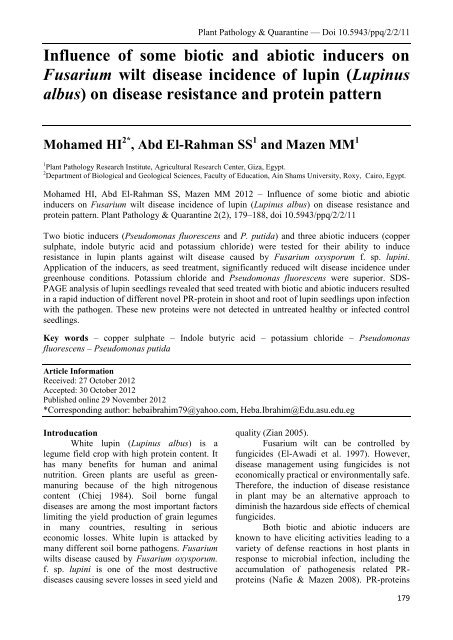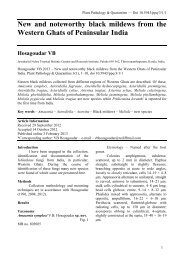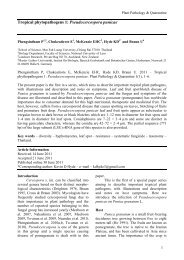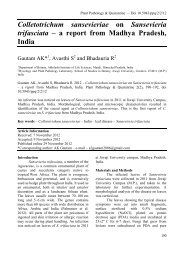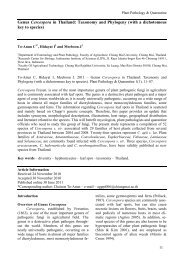View PDF - Plant Pathology & Quarantine
View PDF - Plant Pathology & Quarantine
View PDF - Plant Pathology & Quarantine
You also want an ePaper? Increase the reach of your titles
YUMPU automatically turns print PDFs into web optimized ePapers that Google loves.
<strong>Plant</strong> <strong>Pathology</strong> & <strong>Quarantine</strong> — Doi 10.5943/ppq/2/2/11<br />
Influence of some biotic and abiotic inducers on<br />
Fusarium wilt disease incidence of lupin (Lupinus<br />
albus) on disease resistance and protein pattern<br />
Mohamed HI 2* , Abd El-Rahman SS 1 and Mazen MM 1<br />
1 <strong>Plant</strong> <strong>Pathology</strong> Research Institute, Agricultural Research Center, Giza, Egypt.<br />
2 Department of Biological and Geological Sciences, Faculty of Education, Ain Shams University, Roxy, Cairo, Egypt.<br />
Mohamed HI, Abd El-Rahman SS, Mazen MM 2012 – Influence of some biotic and abiotic<br />
inducers on Fusarium wilt disease incidence of lupin (Lupinus albus) on disease resistance and<br />
protein pattern. <strong>Plant</strong> <strong>Pathology</strong> & <strong>Quarantine</strong> 2(2), 179–188, doi 10.5943/ppq/2/2/11<br />
Two biotic inducers (Pseudomonas fluorescens and P. putida) and three abiotic inducers (copper<br />
sulphate, indole butyric acid and potassium chloride) were tested for their ability to induce<br />
resistance in lupin plants against wilt disease caused by Fusarium oxysporum f. sp. lupini.<br />
Application of the inducers, as seed treatment, significantly reduced wilt disease incidence under<br />
greenhouse conditions. Potassium chloride and Pseudomonas fluorescens were superior. SDS-<br />
PAGE analysis of lupin seedlings revealed that seed treated with biotic and abiotic inducers resulted<br />
in a rapid induction of different novel PR-protein in shoot and root of lupin seedlings upon infection<br />
with the pathogen. These new proteins were not detected in untreated healthy or infected control<br />
seedlings.<br />
Key words – copper sulphate – Indole butyric acid – potassium chloride – Pseudomonas<br />
fluorescens – Pseudomonas putida<br />
Article Information<br />
Received: 27 October 2012<br />
Accepted: 30 October 2012<br />
Published online 29 November 2012<br />
*Corresponding author: hebaibrahim79@yahoo.com, Heba.Ibrahim@Edu.asu.edu.eg<br />
Introducation<br />
White lupin (Lupinus albus) is a<br />
legume field crop with high protein content. It<br />
has many benefits for human and animal<br />
nutrition. Green plants are useful as greenmanuring<br />
because of the high nitrogenous<br />
content (Chiej 1984). Soil borne fungal<br />
diseases are among the most important factors<br />
limiting the yield production of grain legumes<br />
in many countries, resulting in serious<br />
economic losses. White lupin is attacked by<br />
many different soil borne pathogens. Fusarium<br />
wilts disease caused by Fusarium oxysporum.<br />
f. sp. lupini is one of the most destructive<br />
diseases causing severe losses in seed yield and<br />
quality (Zian 2005).<br />
Fusarium wilt can be controlled by<br />
fungicides (El-Awadi et al. 1997). However,<br />
disease management using fungicides is not<br />
economically practical or environmentally safe.<br />
Therefore, the induction of disease resistance<br />
in plant may be an alternative approach to<br />
diminish the hazardous side effects of chemical<br />
fungicides.<br />
Both biotic and abiotic inducers are<br />
known to have eliciting activities leading to a<br />
variety of defense reactions in host plants in<br />
response to microbial infection, including the<br />
accumulation of pathogenesis related PRproteins<br />
(Nafie & Mazen 2008). PR-proteins<br />
179
are inducible proteins implicated in active<br />
defense against disease and they may play a<br />
key role in restricting pathogen development<br />
and spread in plants through their antifungal<br />
activity (Van Loon et al. 2006).<br />
SDS-PAGE analysis revealed rapid<br />
induction of novel PR-proteins in root and<br />
shoot of the induced seedlings in response to<br />
pathogen infection. Such proteins were not<br />
detected in untreated healthy or infected<br />
control.<br />
The objective of this investigation was<br />
to evaluate some biotic and abiotic inducers to<br />
induce resistance in lupin plants against<br />
fusarium wilt disease under greenhouse, and<br />
the relationship between resistance and protein<br />
pattern changes in induced plants.<br />
Materials and methods<br />
Source of fungal pathogen<br />
The fungal pathogen (F. oxysporum f.<br />
sp. lupini) was isolated from diseased lupin<br />
plants collected from Ismailia Governorate and<br />
identified according to Barnett & Hunter<br />
(1986). The isolate proved its pathogenic<br />
capability in the pathogenicity test.<br />
Preparation of fungal inoculum<br />
F. oxysporum f. sp. lupini was grown<br />
on potato dextrose agar (PDA) medium at 25<br />
°C for 12 days. Conidia were then harvested in<br />
sterilized distilled water using a sterile brush<br />
and filtrated through four layers of cheesecloth<br />
to remove the mycelium. The spore suspension<br />
was adjusted to 1 x 10 6 spores/ml using a<br />
haemocytometer (Sharma et al. 2005).<br />
Preparation of Pseudomonas strains<br />
Strains of Pseudomonas fluorescens<br />
and P. putida were provided from Department<br />
of Microbiology, Soil, Water and Environment<br />
Research Institute, ARC, Giza. The bacteria<br />
were cultured individually in nutrient broth<br />
medium in 250 ml flasks and incubated at 28<br />
°C for 48 h, then a cell suspension of each<br />
strain was adjusted to provide 10 9 cfu/ml.<br />
Seed treatment<br />
Surface sterilized seeds of lupin (cv.<br />
Giza 1) were soaked in twice their volume of a<br />
<strong>Plant</strong> <strong>Pathology</strong> & <strong>Quarantine</strong> — Doi 10.5943/ppq/2/2/11<br />
cell suspension of each of the bacterial<br />
inducers or in the individual abiotic inducers<br />
[indole butyric acid (IBA) (2.0 mM),<br />
potassium chloride (KCl) (5 mM) and copper<br />
sulphate (CuSO 4 ) (0.5 mM)], for 18 h at<br />
laboratory temperature. The seeds were then<br />
allowed to air dry. Untreated seeds were used<br />
as a control. Seeds treated with fungicide<br />
(Rizolex- T at the rate of 3g/Kg seeds) were<br />
used as a comparison treatment.<br />
Greenhouse experiment<br />
Pots (35 cm diameter and 25 cm in<br />
depth) containing sterilized soil were sown<br />
with lupin seeds pretreated with P. fluorescens,<br />
P. putida, IBA, KCl, CuSO 4 and fungicide as<br />
well as untreated seeds (served as control<br />
plants). This experiment was conducted under<br />
natural conditions (day length 12-14 hrs,<br />
temperature 25-27 ○ C and humidity 70%).<br />
Twenty days after sowing, potted soil was<br />
infested with a spore suspension of F.<br />
oxysporum f. sp. lupini (1 X 10 6 spore/ml, 100<br />
ml/pot). Pots containing un-infested soil were<br />
sown with untreated seeds as a healthy control.<br />
Three replicates were used for each treatment<br />
and seven seeds were sown in each pot. The<br />
growing seedlings were examined periodically<br />
and disease incidence was recorded at 21 days<br />
after inoculation with the pathogen (Sharma et<br />
al. 2005).<br />
Disease assessment<br />
Disease incidence (percent wilting) was<br />
recorded 21 days after inoculation according to<br />
the following formula<br />
Number of wilted plants<br />
Disease incidence % = × 100<br />
Number of total plants<br />
Protein electrophoresis<br />
Protein extraction<br />
Samples of lupin seedlings (shoot and<br />
root) pretreated with biotic or abiotic inducers<br />
were collected 2 and 5 days after inoculation<br />
with the pathogen. Untreated healthy or<br />
infected seedlings were used as controls. For<br />
SDS-PAGE, 0.5 g of shoots and roots of lupin<br />
seedlings were ground to powder under liquid<br />
nitrogen and melted in ice-cold extraction<br />
180
<strong>Plant</strong> <strong>Pathology</strong> & <strong>Quarantine</strong> — Doi 10.5943/ppq/2/2/11<br />
Fig. 1 – SDS PAGE of soluble proteins extracted from shoot and root of lupin seedlings from seeds<br />
treated with biotic and abiotic inducers and challenged with Fusarium oxysporum f. sp. lupini (two<br />
days after challenge).<br />
181
uffer (0.5 M Tris-HCl, pH 6.5, 1% SDS, 5%<br />
2-mercaptoethanol, 20% sucrose,0.4%<br />
bromophenol blue), followed by centrifugation<br />
at 10,000 g at 4 °C for 15 min. Extracts were<br />
stored at -20 °C until used.<br />
One-dimensional (SDS-PAGE)<br />
Proteins (50 μg of each sample) were<br />
separated by SDS-PAGE according to the<br />
method of Laemmli (1970). The separation was<br />
performed with 12.5% separating gel and 5%<br />
stacking gel using protein vertical<br />
electrophoresis unit. Electrophoresis was<br />
started at 80 V constant current until the<br />
tracking dye entered the separating gel and<br />
continued at 125 V until the tracking dye<br />
reached the end of the gel. The gels were<br />
stained with 0.25% Coomassie Brilliant Blue<br />
R-250 (Sigma) in 50% (v/v) methanol and 10%<br />
(v/v) acetic acid for 2 h and destained with<br />
50% (v/v) methanol and 10% (v/v) acetic acid<br />
until the background was clear. Relative<br />
molecular weight of each protein was<br />
determined using a standard protein marker.<br />
The gel was scanned using Gel Pro-Analyzer.<br />
Statistical analysis<br />
Analysis of variance was carried out<br />
using MSTAT-C program version 2.10 (1991).<br />
Least significant difference (LSD) was<br />
employed to test for significant difference<br />
between treatments at P≤0.05 (Gomez &<br />
Gomez 1984).<br />
Results<br />
Under greenhouse conditions<br />
Lupin seeds pretreated with fungicide,<br />
biotic or abiotic agents significantly reduced<br />
wilt disease incidence compared with untreated<br />
infected control (Table1). Nevertheless,<br />
efficiency of the tested agents varied.<br />
Fungicide treatment ranked as the most<br />
effective (84.6% reduction in disease<br />
incidence), followed by P. fluorescens, KCl, P.<br />
putida and CuSO 4 (76.9, 76.9, 46.2, 38.5%<br />
reduction, respectively), while IBA gave the<br />
lowest protection against the disease (23.06%).<br />
Protein electrophoresis<br />
Seed treatment with biotic and abiotic<br />
agents induced new pathogensis related<br />
<strong>Plant</strong> <strong>Pathology</strong> & <strong>Quarantine</strong> — Doi 10.5943/ppq/2/2/11<br />
proteins with various molecular weights in<br />
shoot and root of lupin seedlings upon<br />
infection with the pathogen (Table 2, 3, Figs. 1,<br />
2). These new proteins were not detected in<br />
untreated healthy or infected control.<br />
After two days of inoculation with the<br />
pathogen (Table 2, Fig. 1), new proteins with<br />
different molecular weights (58, 51 and 38<br />
KDa) were expressed only in the shoot of lupin<br />
seedling pretreated with biotic or abiotic<br />
inducers. At the same time, new proteins with<br />
138, 110, 88, 69, 44 and 24 KDa were found<br />
only in the root of seedlings pretreated with<br />
biotic or abiotic inducers.<br />
Five days after challenging with the<br />
pathogen, another group of novel proteins were<br />
detected only in the shoot and root of seedlings<br />
induced by biotic or abiotic inducers (Table 3,<br />
Fig. 2). Proteins of 64, 43, 26, and 15 KDa<br />
were detected in the shoot of induced<br />
seedlings, whereas, proteins of 88, 36 and 32<br />
KDa were detected in the root of induced<br />
seedlings.<br />
Discussion<br />
Resistance inducers provide an<br />
additional option to manage plant diseases<br />
while maintaining sustainable production.<br />
Results obtained in this investigation indicated<br />
that application of biotic and abiotic inducers<br />
as seed treatment significantly reduced wilt<br />
disease incidence under greenhouse conditions<br />
compared with untreated controls. A<br />
comparative evaluation showed that the tested<br />
inducers varied in their effectiveness against<br />
lupin wilt disease. P. fluorescens (biotic<br />
inducer) and KCl (abiotic inducer) were the<br />
most effective treatments.<br />
Strains of Pseudomonas spp. have been<br />
reported to induce resistance against fusarium<br />
wilt disease on several plant species. Saikia et<br />
al. (2003) used different isolates of P.<br />
fluorescens as seed treatment to induce<br />
resistance against F. oxysporum f. sp. ciceri in<br />
chickpea. They found that the isolates<br />
significantly reduced wilt disease incidence by<br />
26-50% compared to the control. In addition,<br />
P. fluorescens and P. putida successfully<br />
reduced fusarium wilt disease incidence in<br />
induced tomato seedlings (Maina et al. 2008).<br />
Similarly, induced resistance by abiotic<br />
inducers is another promising approach to<br />
182
<strong>Plant</strong> <strong>Pathology</strong> & <strong>Quarantine</strong> — Doi 10.5943/ppq/2/2/11<br />
Table 1 Effect of seed treatment with biotic and abiotic inducers on Fusarium wilt disease<br />
incidence in lupin plants 21 days after inoculation under greenhouse conditions. Means ± SD<br />
(n=10) of measurements on each ten plants. Means followed by a are significantly decrease at<br />
P≤0.05, according to least significant difference (LSD) test.<br />
Treatment Disease incidence %<br />
Reduction over control<br />
%<br />
Indole butyric acid (IBA) 2.0 mM 47.6±2.02a 23.1<br />
Copper sulphate (CuSO 4 ) 0.5 mM 38.1±1.33a 38.5<br />
Potassium chloride (KCl) 5 mM 14.3±0.99a 76.9<br />
P. fluorescens 10 9 cfu/ml 14.3±0.87a 76.9<br />
P. putida 10 9 cfu/ml 33.3±1.14a 46.2<br />
Fungicide (Rhizolex-T) 3g/Kg 9.5±0.54a 84.6<br />
Control 61.9±2.11 -<br />
L.S.D. at 5% 16.33 -<br />
decrease fusarium wilt diseases. Application of<br />
potassium chloride (KCl) as seed treatment<br />
effectively suppressed fusarium wilt disease in<br />
sesame plants under greenhouse and field<br />
conditions (Shalaby 1997). Cotton seedlings<br />
induced by methyl jasmonate showed the<br />
lowest wilt disease incidence caused by F.<br />
oxysporum f. sp. vasinfectum (Couto et al.<br />
2009). Also, Sarwar et al. (2010) showed that<br />
chickpea seed treatment with bion, salicylic<br />
acid and potassium phosphate reduced<br />
fusarium wilt disease by 63, 40 and 30%,<br />
respectively.<br />
<strong>Plant</strong> growth promotion is another<br />
beneficial effect of Pseudomonas spp. The<br />
mechanisms by which these bacteria affect<br />
plants involve the production of<br />
phytohormones (indole acetic acid, gibberallin<br />
and cytokinin) and other associated activities<br />
which include phosphate solubilization in soil<br />
resulting in stimulation of sunflower plant<br />
growth (Bhatia et al. 2005). Obtained results<br />
were consistent with those reported by<br />
Govindappa et al. (2010). They found that<br />
application of P. fluorescens as seed treatment<br />
enhanced safflower plant growth and increased<br />
seed yield of induced plants. As for abiotic<br />
inducers, Shalaby (1997) indicated that seed<br />
treatment with Kcl significantly increased seed<br />
yield of sesame plants. Similarly, Abdel-<br />
Monaim (2008) showed that application of<br />
abiotic inducers as seed treatment was<br />
accompanied with pronounced increase of crop<br />
parameters and seed yield of lupin plants.<br />
Generally, it could be concluded that<br />
induction of resistance by some abiotic and/or<br />
biotic inducers, especially P. fluorescens<br />
and/or KCl, to control soil borne disease may<br />
provide a practical supplement to<br />
environmentally friendly disease management<br />
when they are combined with appropriate<br />
integrated agronomic practices.<br />
SDS- PAGE analysis of lupin seedlings<br />
revealed that seed treated with biotic and<br />
abiotic inducers resulted in a rapid induction of<br />
different novel PR-protein in shoot and root of<br />
lupin seedlings upon infection with the<br />
pathogen. These new proteins were not<br />
detected in untreated healthy or infected<br />
control. Two days after inoculation with the<br />
pathogen, proteins of 58 and 110 KDa<br />
expressed only in shoot and root of seedlings,<br />
respectively, induced by KCl (which recorded<br />
maximum protection against wilt disease<br />
incidence). Similarly protein of 88 KDa<br />
detected only in shoot of seedlings induced by<br />
Kcl, P. fluorescens and P. putida (the most<br />
effective treatments). Furthermore, protein of<br />
24 KDa synthesis in response to all biotic and<br />
abiotic treatments except IBA (the least<br />
effective inducer). Such protein may have a<br />
critical role in plant resistance mechanism.<br />
Woloshuk et al. (1991) reported that<br />
protein of 24 KDa is related to osmtin, a<br />
member of the pathogen related protein (PR-5)<br />
and have antifungal effect. Thus, it could be<br />
suggested that in resistance induced plants the<br />
accumulation of PR-proteins forms the first<br />
line of defense to a challenging pathogen and<br />
they are implicated in plant defense because of<br />
their antifungal activity (Van-Loon 1997).<br />
Another group of novel proteins with<br />
different molecular weights synthesis only in<br />
induced seedlings five days after infection with<br />
183
<strong>Plant</strong> <strong>Pathology</strong> & <strong>Quarantine</strong> — Doi 10.5943/ppq/2/2/11<br />
Fig.2 – SDS PAGE of soluble proteins extracted from shoot and root of lupin seedlings from seeds<br />
treated with biotic and abiotic inducers and challenged with Fusarium oxysporum f. sp. lupini (five<br />
days after challenge).<br />
184
<strong>Plant</strong> <strong>Pathology</strong> & <strong>Quarantine</strong> — Doi 10.5943/ppq/2/2/11<br />
Table 2 The amounts of soluble proteins extracted by SDS PAGE from shoot and root of lupin seedlings from seeds treated with biotic and abiotic<br />
inducers two days after challenge with Fusarium oxysporum f. sp. lupini.<br />
Marker<br />
(Mol.wt.)<br />
shoots<br />
Untreated Untreated<br />
P. P. Untreated Untreated<br />
P. P.<br />
IBA CuSO<br />
healthy infected<br />
4 Kcl<br />
IBA CuSO<br />
fluorescens putida healthy infected<br />
4 Kcl<br />
fluorescens putida<br />
166 5.23 2.78 4.39 2.6<br />
147 2.77 3.01 1.6 2.48 2.73 3.03 1.99 1.8 2.4 2.69<br />
138 1.52 1.41 1.88 1.93 1.8 2.62 2.54<br />
131 4.65 5.04 3.85 2.08 3.88 6.07 4.81 4.33 2.77 3.04 2.21<br />
110 2.37 2.52 1.84 2.14<br />
103 2.68 2.12 2.48 2.97 1.92 1.64 2.02 4.25 4.97 6.47 4.68 3.91 4.25<br />
88 1.56 2.74 3.83 1.84 2.26 2.65 2.84 4.12 2.17 2.78<br />
78 2 2.3 1.78 1.15<br />
69 2.65 2.53 10.5 1.72 2.7 1.71 2.8<br />
58 1.96 3.48 2.85 5.21 7.32 5.58 4.54<br />
51 2.23 10.8 11.5 3.08 1.84 7.16<br />
44 16.3 12.6 9.44 2.36 8.17 4.87 1.23<br />
42 3.56 1.97<br />
38 1.97 1.95 2.29 2.13<br />
35 1.6 1.9 4.04 2.76 2.13 4.61 2.2 2.84 3.22 3.42 3.2 3.72<br />
32 8.17 3.14 2.88 3.6 5.32 3.87 4.11<br />
30 1.8 3.84 4.03 5.39 5.25 3.49 4.62 6.42<br />
26 1.31 3.33 1.85 4.42<br />
24 2.01 2.46 6.67 1.72 6.24 3.62 3.14 2.95<br />
23 4.04 3.86<br />
22 2.35 2.55 4.23 4.77 6.8 7.21<br />
21 4.43 2.65 2.35 5.58 3.2 6.5 7.24 6.84 5.9<br />
19 4.2 7.29<br />
18 2.49 2.52 3.38 6.35 2.81 4.73 8.31 4.24 4.81 4.15 5.43 6.05 4.99<br />
Sum 24.1 60.5 48.2 38.1 46.4 59.2 47 51 41 34 41.6 46.1 35.9 43.3<br />
No. of<br />
bands<br />
14 15 11 13 17 14 12 11 10 10 9 9 10 12<br />
roots<br />
185
<strong>Plant</strong> <strong>Pathology</strong> & <strong>Quarantine</strong> — Doi 10.5943/ppq/2/2/11<br />
Table 3 The amounts of soluble proteins extracted by SDS PAGE from shoot and root of lupine seedlings from seeds treated with biotic and abiotic<br />
inducers after five days challenge with Fusarium oxysporum f. sp. lupini.<br />
Marker<br />
(Mol.wt.<br />
)<br />
Untreated<br />
healthy<br />
Untreated<br />
infected<br />
shoots<br />
IBA CuSO 4 Kcl<br />
P.<br />
fluorescens<br />
P.<br />
putida<br />
Untreated<br />
healthy<br />
Untreated<br />
infected<br />
IB<br />
A<br />
roots<br />
CuSO 4<br />
Kcl<br />
P.<br />
fluorescens<br />
P.<br />
putida<br />
138 5.54 5.27 3.75 3.81 3.11 3.47 2.69 2.9 3.02 3.98 6.16<br />
113 2.92 3.08 1.63 3 2.74 1.12 2.58 6.39 5.34<br />
102 2.93 1.51 2.03 1.88 6.69 6.56 3.69<br />
88 1.63 2.37 2.99 2.61 3 3.54 3.53 6.4 7.72<br />
72 3.17 2.43 2.74 2.52 4.55<br />
64 4.48 4.25 3.06 2.27 6.38 8.38<br />
60 6.86 5.05 5.1 7.87 8.08 7.02<br />
53 15 9.35 14.3 14.5 12.8 9.38<br />
45 2.28<br />
43 7.66 2.66<br />
38 4.96 4.35 6.76 8.41 6.81 8.57 9.11<br />
36 6.87 5.77 6.75 5.38 3.34 7.75 7.64<br />
32 1.81 3.65 4.08 3.25 5.2 8.08 8.82<br />
29 2.37 2.66 3.07<br />
26 3.76 4.15 5.41 8.19 3.76 6.96 4.9 5.15 5.76 4.2 6.34<br />
20 3.91 5.25 6.78 10.3 9.27 14.1 5.66 5.96<br />
17 17.1 14.5 6.34<br />
15 12.5 1.44 1.19 5.27<br />
13 9.73<br />
Sum 56.5 42 56.6 50.6 38.8 34.2 44.6 34.9 34.4 42.1 45.2 50.6 46.4 50.3<br />
No. of<br />
bands<br />
9 9 9 9 8 8 12 8 6 7 7 7 7 7<br />
186
the pathogen. Among them, protein of 15 KDa<br />
expressed in the shoot of lupin seedling<br />
induced by KCl, CuSO 4 and P. fluorescens<br />
(which recorded high protection against wilt<br />
disease incidence). In addition, protein of 26<br />
KDa is one of (PR-3) members which belong<br />
to endochitinases. Chitinases have the potential<br />
to hydrolyse chitin (a major component of<br />
fungal cell walls) resulted in suppressing<br />
disease development (Radjacommare et al.<br />
2004).<br />
On the other side, in root of lupin<br />
seedlings, protein of 32 KDa expressed upon<br />
infection with the pathogen in all biotic and<br />
abiotic inducers and not detected in untreated<br />
healthy or infected control. In this respect,<br />
Nafie & Mazen (2008) consider such protein<br />
expression may enhance plant responses to<br />
overcome further pathogen invasion. In<br />
addition, new protein of 36 KDa was detected<br />
only in root of seedling induced by the most<br />
effective treatments (Kcl and P. fluorescens).<br />
Protein of 36 KDa belonging to PR-2 and was<br />
identified as β- 1,3 glucanase.<br />
References<br />
Abdel-Monaim MF. 2008 – Pathological<br />
studies of foliar and root diseases of<br />
lupine with special reference to induced<br />
resistance. Ph.D. Thesis, Faculty<br />
Agricultural Minia University.<br />
Barnett HL, Hunter BB. 1986 – Illustrated<br />
genera of imperfect fungi, 4 th edition. St.<br />
Paul, M.N., APS Press. Macmillan<br />
Publishing, New York. pp.217.<br />
Bhatia S, Dubey RC, Maheshwari DK. 2005 –<br />
Enhancement of plant growth and<br />
suppression of collar rot of sunflower<br />
caused by Sclerotium rolfsii through<br />
Pseudomonas fluorescens. Indian<br />
Phytopathology 58, 17–24.<br />
Chiej R. 1984 – The Macdonald Encyclopedia<br />
of Medicinal <strong>Plant</strong>s. MacDonald,<br />
London. 447 pp.<br />
Couto EF, Coelho RSB, Suassuna ND, Oliveira<br />
SMA. 2009 – Evaluation of induced<br />
resistance to Fusarium wilt in cotton:<br />
elicited enzymatic activity and disease<br />
index. Tropical <strong>Plant</strong> <strong>Pathology</strong> 34, 352–<br />
356.<br />
El-Awadi FA, Ismail IA, Essmat NEA. 1997 –<br />
<strong>Plant</strong> <strong>Pathology</strong> & <strong>Quarantine</strong> — Doi 10.5943/ppq/2/2/11<br />
Evaluation of lupin entries and<br />
fungicides against root rot and wilt<br />
disease of lupin. 8 th Congress of the<br />
Egyption Phytopathology Society Cairo,<br />
393–401.<br />
Gomez KA, Gomez AA. 1984 – Statistical<br />
Procedures for Agricultural Research. A.<br />
Lviley Interscience, New York. pp.678.<br />
Govindappa M, Lokesh S, Rai VR, Nail VR,<br />
Raju SG. 2010 – Induction of systemic<br />
resistance and management of safflower<br />
Macrophomina phaseolina root rot<br />
disease by biocontrol agents. Archives<br />
Phytopathology <strong>Plant</strong> Protection 43(1-3),<br />
26–40.<br />
Laemmli UK. 1970 – Cleavage of structural<br />
proteins during assembly of head<br />
bacteriophage T 4 . Nature 227, 680–685.<br />
Maina M, Hauschild R, Sikora R. 2008 –<br />
Protection of tomato plants against<br />
fusaric acid by resistance induction.<br />
Journal of Applied Biosciences 1, 18–31.<br />
MSTAT-C. 1991 – A software program for the<br />
design, management and analysis of<br />
agronomic research experiments.<br />
Michigan State University, pp. 400.<br />
Nafie E, Mazen MM. 2008 – Chemical induced<br />
resistance against brown stem rot in<br />
soybean: the effect of benzothiadiazole.<br />
Journal of Applied Sciences Research<br />
4(12), 2046–2064.<br />
Radjacommare R, Kandan A, Nandakumar R,<br />
Samiyappan R. 2004 – Association of the<br />
hydrolytic enzymes chitinase against<br />
Rhizoctonia solani in Rhizobacteria<br />
treated rice plants. Journal of<br />
Phytopathology 152, 365-370.<br />
Saikia R, Singh T, Kumar R, Srivastava J,<br />
Srivastavaa AK, Singh K, Arora D K.<br />
2003 – Role of salicylic acid in systemic<br />
resistance induced by Pseudomonas<br />
fluorescens against Fusarium oxysporum<br />
f. sp. ciceri in chickpea. Microbiological<br />
Research 158, 203–213.<br />
Sarwar N, Zahid MHC, Haq I. 2010 – Seed<br />
treatments induced systemic resistance in<br />
chickpea against fusarium wilt in wilt<br />
sick field. Pakistan Journal of Botany<br />
42(5), 3323–3326.<br />
Shalaby SIS. 1997 – Induction of systemic<br />
resistance in sesame plants for<br />
controlling fusarium wilt disease. Al-<br />
187
Azhar Journal of Agriculture Research<br />
25, 17–29.<br />
Sharma KD, Chen W, Muehlbauer FJ, 2005 –<br />
Genetics of chickpea resistance to five<br />
races of fusarium wilt and a concise set<br />
of race differentials for Fusarium<br />
oxysporumf sp. ciceri. <strong>Plant</strong> Disease 89,<br />
385–390.<br />
Van-Loon LC, 1997 – Induced resistance in<br />
plants and the role of pathogenesis<br />
related proteins. European Journal plant<br />
<strong>Pathology</strong> 103,753–765.<br />
<strong>Plant</strong> <strong>Pathology</strong> & <strong>Quarantine</strong> — Doi 10.5943/ppq/2/2/11<br />
Van-Loon LC, Rep M, Pieterse CMJ, 2006 –<br />
Significance of inducible defense related<br />
proteins in infected plants. Annual<br />
Review of Phytopathology 44, 135–162.<br />
Woloshuk CP, Meulenhofb JS, Sela-Buurlage<br />
M, VandenElzen PJM, Comelissen BJC,<br />
1991 – Pathogen induced proteins with<br />
inhibitory activity toward Phytophthora<br />
infestans. <strong>Plant</strong> Cell 3, 619–628.<br />
Zian AH, 2005 – Studies on lupine root rot and<br />
wilt disease. M.Sc. Thesis, Faculty of<br />
Agriculture, Suez Canal University,<br />
Egypt.<br />
188


